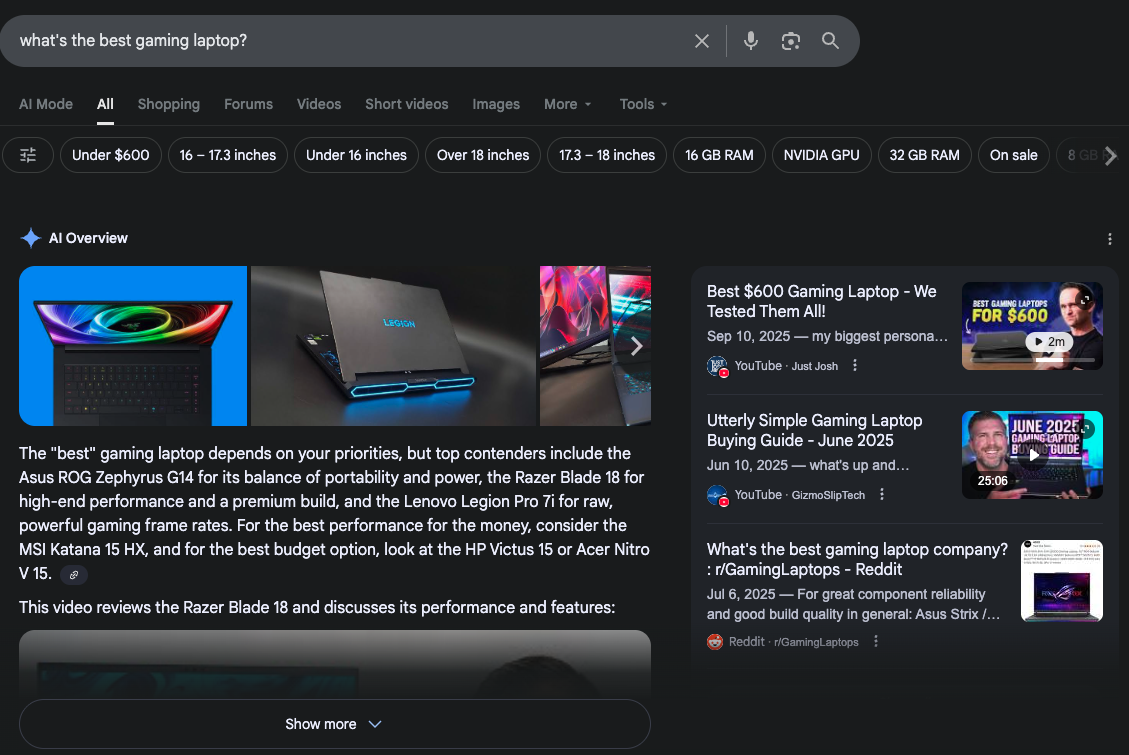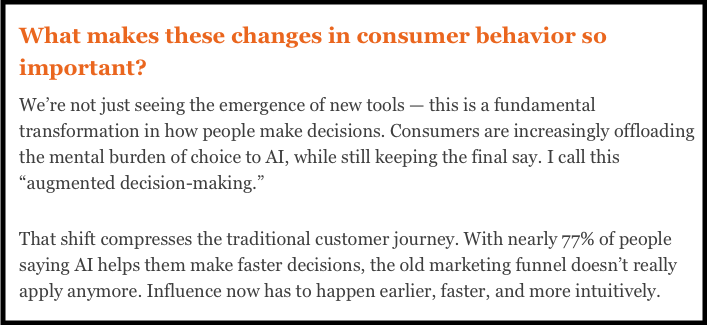The introduction of AI search didn’t just cause organic traffic to fall at record numbers, it also fundamentally restructured the SEO sales funnel.
The classic funnel looked like this:
- Awareness
- Consideration
- Conversion
It’s a linear, cause-and-effect model that’s worked for decades.
First, you draw in your audience with helpful, informative content (awareness). Then, you convince them that your brand stands head and shoulders above the rest with reviews and buyers’ guides (consideration).
Lastly, you persuade prospects to convert with high-quality landing pages and strong CTAs (conversion).
What’s changed with AI search?
While the stages are still the same, the model is no longer linear and can loop into new shopping experiences. AI search assistants and chatbots allow users to skip stages, blend stages, and loop back to the start for a new product.
The good news is that there are plenty of ways to use the newly rebuilt AI visibility funnel to your advantage. Play your cards right, and LLMs will act as loyal brand advocates, serving up qualified leads for you on a silver platter.
In this post, we’ll show how AI search platforms reinvented the SEO funnel, and we’ll teach you how to alter your content strategy to optimize for it.
How AI Search Transformed the Discovery Process
The most significant impact of AI search is how it’s changed the way users discover online content.
Before Google’s AI Overviews and platforms like ChatGPT, search engines were largely middlemen that existed to connect users with relevant websites.
Even if users were only after simple definitions and answers, they’d still have to click on one of the ‘blue links’ (the organic results) to find what they were looking for.

Granted, there were still Featured Snippets that would provide quick answers to simple queries. First introduced in 2014, they did cause some searches to end in zero clicks, but they:
- Were limited to informational queries, so they were strictly for users who wanted to find information instead of products or services. Featured Snippets did not generate for commercial or transactional queries, which safeguarded moneymaking content.
- Highlighted a single search result, which often resulted in a ton of traffic for the cited website (this is why SEOs targeted ‘position zero’).
- Did not take up a significant portion of the search results page, so other organic results were often still visible.
Because of these factors, Featured Snippets only caused a marginal rise in zero-click searches, and they didn’t fundamentally change the discovery process.
For many years, the primary way users satisfied their search intent was to click through to one of the organic results. This drove plenty of traffic to websites across the internet, and site owners were able to transform web visits into conversions with optimized content.
Features like Google’s AI Overviews (AIOs), however, have caused zero-click searches to become the majority.
The Impact of Google’s AI Overviews On Search Behavior
In late 2024, research by Rand Fishkin uncovered that a whopping 60% of all online searches ended in zero clicks, and that number has likely been steadily rising since.
After all, Google made AI Overviews more prominent in early 2025, and they started appearing for all types of search queries, not just informational ones. That means AI Overviews can generate (and dominate the results page) for commercial queries, also known as the search terms that drive revenue.
For example, here’s an AI Overview for the commercial keyword ‘what’s the best gaming laptop?’:
As you can see, an AIO generates at the top of the page, and Google’s LLM Gemini has plenty of suggestions. It gives direct brand recommendations to brands like Asus, Razer, and Lenovo.
If you were actually shopping for a gaming laptop, you’ve already got a handful of viable options, and you haven’t clicked on a single search result. In fact, since the AIO is present, you’re far less likely to scroll down to even look at any organic results.
According to Ahrefs, the presence of an AIO can reduce click-through rates by 34.5%, so there’s hard evidence that AIOs actively reduce organic traffic (it’s far from the only study covering this phenomenon; research by Seer Interactive and GrowthSRC found similar results).
How AI rebuilt the buyer’s journey
Instead of scrolling down, you’re more likely to continue your buyer’s journey with what the AIO gave you. Brand recommendations from LLMs read like word-of-mouth recommendations, and users tend to trust them.
According to the University of Virginia Darden School of Business, 60% of consumers use AI for shopping, and they trust its recommendations more than those of their own friends and family.
This high level of trust is a major reason why AI tools have changed the SEO funnel.
In the past, during the consideration stage, users would consume online content like reviews, buyers’ guides, and product roundups. After weighing the pros and cons, they’d eventually make a purchase decision.
With LLM-powered search assistants, though, many consumers are willing to outsource the deliberation process to AIs:
What the AI-Powered Visibility Funnel Looks Like Now
Before we dive into optimizing for the AI search funnel, let’s examine its structure.
It’s no longer linear since users are able to skip and repeat stages. Also, it’s no longer self-contained since the conversation never ends with LLMs; it just pivots to something new.
That’s because every prompt is part of an ongoing discovery loop. LLMs will ‘remember’ users’ past conversations, purchases, and preferences, and build upon them in future responses (like by recommending similar products or related accessories).
For this reason, it’s better to visualize the AI buying experience as a web or a loop instead of a classic funnel:
It’s less rigid, more dynamic, and more effective than the traditional funnel (due to the quality of traffic it delivers).
With a new funnel comes new optimization techniques, so you don’t want to stick to an antiquated playbook. Instead of obsessing over search rankings and creating content for each funnel stage, you’ll want to focus on things like:
- Semantic retargeting
- Memorable brand phrasing
- Structured data and clear formatting
- Review and reputation management
- Multichannel entry points
Let’s take a closer look at each tactic.
#1: Encouraging loops with semantic retargeting
Since chatbots can loop users into new buying experiences, you can encourage this with semantic retargeting.
Remember, your audience isn’t heading ‘back’ to the search results to start a new buyer’s journey; they’re continuing the conversation with their favorite LLM. Therefore, instead of retargeting your audience through search ads, you can retarget them semantically by building strong trust and entity understanding with LLMs.
Here’s how it works.
First, you need a library of content that covers all topics related to your products and services. Aim for semantic breadth so that your brand name appears for relevant subtopics and accessories.
When creating this content, use consistent language and tone.
This helps LLMs tightly associate your brand’s entity with pretty much everything related to what you do. Next, own your brand’s narrative online by ensuring all your brand mentions tell the same cohesive story. This level of consistency solidifies the connection between your brand and your niche.
Once you’ve established a strong level of trust with LLMs, they’ll still recall you as relevant, even when a user’s intent evolves.
#2: Using memorable brand phrasing
Does your brand sound like a million other brands, or do you have a truly unique voice? If it’s the former, there’s work to do. The more distinctive your brand’s voice is, the more likely AIs are to quote you verbatim.
Why is this important?
Because traditional CTAs don’t exist in AI-generated answers. An LLM may conversationally recommend your brand, but there won’t be a shiny ‘Buy Now’ button or a line encouraging readers to ‘act fast.’
Because of this, you have to get creative about how you build trust and drive conversions. A unique, catchy brand voice can spark a sense of familiarity powerful enough to persuade prospects to give your brand a try.
#3: LLM-friendly formatting and structured data 
Making your content machine-readable is key to achieving AI search visibility. While adding structured data to your website won’t guarantee citations or build authority, it does make it easier for LLMs to parse and properly understand your content.
In particular, semantic HTML and schema markup work together to:
- Label aspects of your content (reviews, products, prices, author bios)
- Help LLMs form accurate associations (like that your organization is the same as the one on your Wikipedia page)
Besides structured data, concise formatting is also a must. Use proper headings and subheadings, bulleted lists, short paragraphs, and clear Q&A sections (tagged with schema). These make it exceptionally easy for LLMs to read and cite your content in generated responses.
#4: Review and reputation management
Brand sentiment and community engagement signals both matter to LLMs. Accordingly, your brand needs mostly positive reviews and a strong reputation on UGC platforms like Reddit and Quora.
If you aren’t actively responding to reviews and monitoring your reputation, you risk losing visibility due to negative online reception. Ensure that you respond to negative reviews (and try to resolve their issues), encourage customers to leave reviews, and engage in relevant community discussions.
#5: Multichannel entry points 
Lastly, you should diversify your traffic sources. Instead of just posting content on your website and hoping that it ranks, the new play is to include as many channels as possible.
Post your content on social media platforms like LinkedIn and X. Make video content for TikTok, YouTube, and Instagram. Guest post on other blogs and make podcast appearances.
That way, whenever AI tools do bring up your brand, users will have multiple ‘doors’ they can use to find you (so that they can hopefully convert).
Final Takeaways: Leveraging the AI Visibility Loop
To summarize, SEO is no longer about driving users down a linear, step-driven funnel. Instead, it’s about ensuring your brand gets referenced as often as possible by LLMs for relevant prompts.
That means building enough trust and credibility that you’ll become the go-to brand that LLMs recommend for prompts related to your products and services.
To learn more, check out our future GEO guide.
What comes next?
Book a call with one of our experts to learn how visibility starts before the SERP.

















































































































































